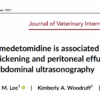Fig. 1: The classic starting point and depth at the AFAST®-TFAST® Diaphragmatico-Hepatic (DH)H view. Note the thin white (hyperechoic) line that represents the typical unremarkable gallbladder wall; and that adequate depth beyond the diaphragm allows the surveillance for pericardial effusion, the other major rule out in collapsed dogs with the gallbladder halo sign.
The sonographic finding of the gallbladder halo sign has been reported to be helpful as a marker for anaphylaxis (AX) in dogs since their shock organ (where most mast cells reside) is their liver and gastro-intestinal tract (unlike humans and cats that have the lungs as their shock organ). The massive histamine release causes acute hepatic congestion due to constriction of hepatic venous outflow (Quantz et al. JVECC 2009). Of course, other signs are helpful for the diagnosis of AX including acute gastrointestinal signs (vomiting and defecating) with collapse, an elevated lactate, an elevated alanine transaminase (ALT). and hemoconcentration. The image below shows a massive gallbladder halo sign at the AFAST®-TFAST® DH view at triage within minutes of patient arrival.
This is just a preview of the full blog post. Sign up for Premium Membership to read full, archived blog posts and to view our video library with video of the gallbladder halo sign and our archived Webinar on the Gallbladder Halo Sign.





